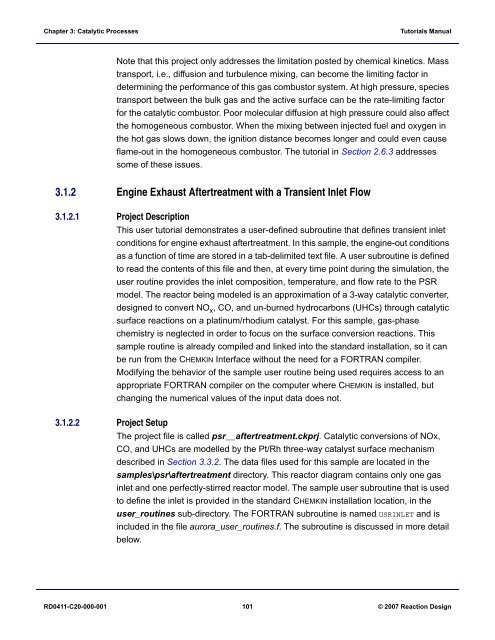Tutorials Manual
Tutorials Manual
Tutorials Manual
You also want an ePaper? Increase the reach of your titles
YUMPU automatically turns print PDFs into web optimized ePapers that Google loves.
Chapter 3: Catalytic Processes<br />
<strong>Tutorials</strong> <strong>Manual</strong><br />
Note that this project only addresses the limitation posted by chemical kinetics. Mass<br />
transport, i.e., diffusion and turbulence mixing, can become the limiting factor in<br />
determining the performance of this gas combustor system. At high pressure, species<br />
transport between the bulk gas and the active surface can be the rate-limiting factor<br />
for the catalytic combustor. Poor molecular diffusion at high pressure could also affect<br />
the homogeneous combustor. When the mixing between injected fuel and oxygen in<br />
the hot gas slows down, the ignition distance becomes longer and could even cause<br />
flame-out in the homogeneous combustor. The tutorial in Section 2.6.3 addresses<br />
some of these issues.<br />
3.1.2 Engine Exhaust Aftertreatment with a Transient Inlet Flow<br />
3.1.2.1 Project Description<br />
This user tutorial demonstrates a user-defined subroutine that defines transient inlet<br />
conditions for engine exhaust aftertreatment. In this sample, the engine-out conditions<br />
as a function of time are stored in a tab-delimited text file. A user subroutine is defined<br />
to read the contents of this file and then, at every time point during the simulation, the<br />
user routine provides the inlet composition, temperature, and flow rate to the PSR<br />
model. The reactor being modeled is an approximation of a 3-way catalytic converter,<br />
designed to convert NO x , CO, and un-burned hydrocarbons (UHCs) through catalytic<br />
surface reactions on a platinum/rhodium catalyst. For this sample, gas-phase<br />
chemistry is neglected in order to focus on the surface conversion reactions. This<br />
sample routine is already compiled and linked into the standard installation, so it can<br />
be run from the CHEMKIN Interface without the need for a FORTRAN compiler.<br />
Modifying the behavior of the sample user routine being used requires access to an<br />
appropriate FORTRAN compiler on the computer where CHEMKIN is installed, but<br />
changing the numerical values of the input data does not.<br />
3.1.2.2 Project Setup<br />
The project file is called psr__aftertreatment.ckprj. Catalytic conversions of NOx,<br />
CO, and UHCs are modelled by the Pt/Rh three-way catalyst surface mechanism<br />
described in Section 3.3.2. The data files used for this sample are located in the<br />
samples\psr\aftertreatment directory. This reactor diagram contains only one gas<br />
inlet and one perfectly-stirred reactor model. The sample user subroutine that is used<br />
to define the inlet is provided in the standard CHEMKIN installation location, in the<br />
user_routines sub-directory. The FORTRAN subroutine is named USRINLET and is<br />
included in the file aurora_user_routines.f. The subroutine is discussed in more detail<br />
below.<br />
RD0411-C20-000-001 101 © 2007 Reaction Design
















